The Chungshan Institute of Science and Technology yesterday unveiled its newest tactical close-range rotary-wing uncrewed aerial vehicle (UAV), saying that once it enters service, it would be tasked with tactical reconnaissance and monitoring of littoral and coastal areas.
The drone has a larger carrying capacity than its predecessors, can stay airborne for longer periods, provide extended monitoring of specific areas and withstand up to Beaufort scale 6 winds, the institute told a news conference in Taichung.
The Republic of China Army ordered 50 drones at a cost of NT$779.98 million (US$25.1 million) and has received 14 as of this year, army Chief of Staff Chang Yuan-hsun (章元勳) has said.
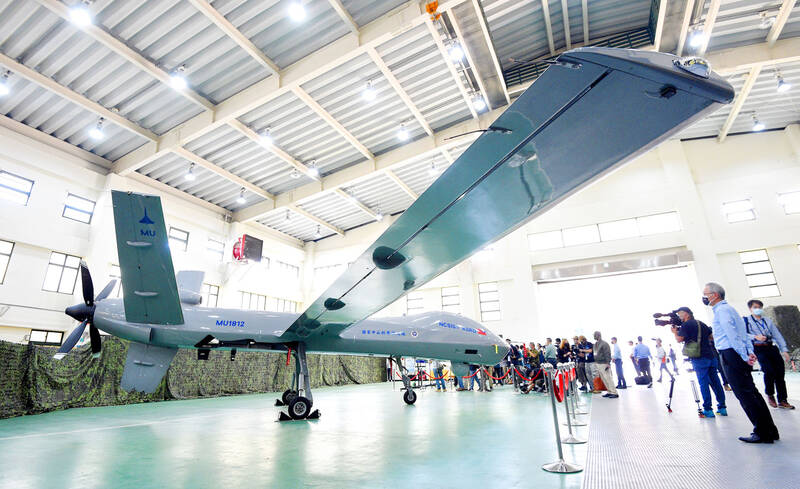
Photo: Lo Pei-te, Taipei Times
With the institute’s assistance, the army has 115 trained operators who have passed certification tests by the Civil Aeronautics Administration, Chang said.
The drone has a navigation and control radius larger than 30km, which, coupled with its ability to stay airborne for more than an hour, could enhance the military’s ability to reconnoiter and gain intelligence beyond visual range in real-time, said Chi Li-ping (齊立平), director of the institute’s Aeronautical Systems Research Division.
The drone can take off or return to base with just a tap of a button, follow preset routes and stay stationary to collect information, Chi added.
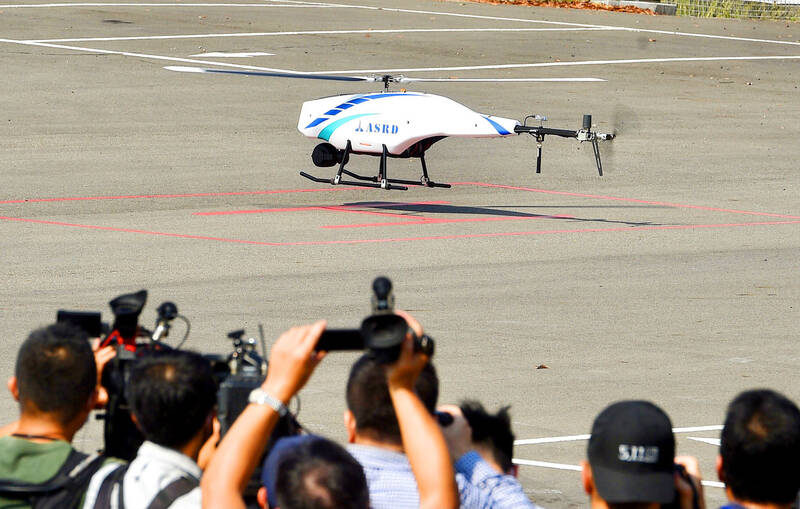
Photo: Lo Pei-te, Taipei Times
The institute also introduced the Teng Yun, or “Cloud Rider,” a large UAV designed to focus on range and digital intelligence gathering, the institute said.
Teng Yun can reach altitudes that allow it to be guided and controlled by satellites, stay airborne for long periods, has a large payload capacity, can autonomously land and take off via multiple uplink navigation and control uplink methods, and can provide long-range monitoring in real-time, it said.
Once fielded, the Teng Yun would allow the military’s drone fleet to be guided and controlled via satellite, the institute said, adding that it has completed development evaluations and is to undergo combat evaluations next year.
Asked what measures are being taken to prevent the use of China- manufactured parts, Chi said the institute conducts a thorough background check of all partner corporations and only collaborates with a company after verifying that it is not funded by Chinese capital and does not conduct large business transactions with China.
The institute also conducts rigorous security checks on all outgoing and incoming personnel while ensuring that all companies bidding for its projects sign a non-disclosure agreement and provide certified proof of the origins of their products, Chi said.

Taiwan is projected to lose a working-age population of about 6.67 million people in two waves of retirement in the coming years, as the nation confronts accelerating demographic decline and a shortage of younger workers to take their place, the Ministry of the Interior said. Taiwan experienced its largest baby boom between 1958 and 1966, when the population grew by 3.78 million, followed by a second surge of 2.89 million between 1976 and 1982, ministry data showed. In 2023, the first of those baby boom generations — those born in the late 1950s and early 1960s — began to enter retirement, triggering
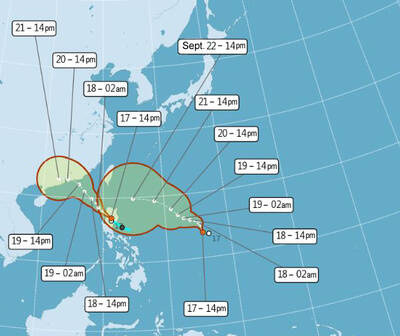
One of two tropical depressions that formed off Taiwan yesterday morning could turn into a moderate typhoon by the weekend, the Central Weather Administration (CWA) said yesterday. Tropical Depression No. 21 formed at 8am about 1,850km off the southeast coast, CWA forecaster Lee Meng-hsuan (李孟軒) said. The weather system is expected to move northwest as it builds momentum, possibly intensifying this weekend into a typhoon, which would be called Mitag, Lee said. The radius of the storm is expected to reach almost 200km, she said. It is forecast to approach the southeast of Taiwan on Monday next week and pass through the Bashi Channel
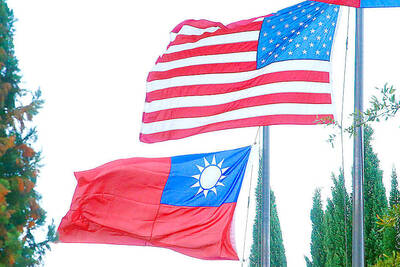
NO CHANGE: The TRA makes clear that the US does not consider the status of Taiwan to have been determined by WWII-era documents, a former AIT deputy director said The American Institute in Taiwan’s (AIT) comments that World War-II era documents do not determine Taiwan’s political status accurately conveyed the US’ stance, the US Department of State said. An AIT spokesperson on Saturday said that a Chinese official mischaracterized World War II-era documents as stating that Taiwan was ceded to the China. The remarks from the US’ de facto embassy in Taiwan drew criticism from the Ma Ying-jeou Foundation, whose director said the comments put Taiwan in danger. The Chinese-language United Daily News yesterday reported that a US State Department spokesperson confirmed the AIT’s position. They added that the US would continue to
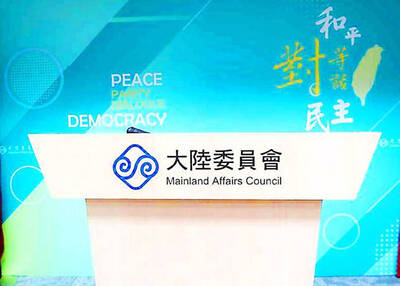
The number of Chinese spouses applying for dependent residency as well as long-term residency in Taiwan has decreased, the Mainland Affairs Council said yesterday, adding that the reduction of Chinese spouses staying or living in Taiwan is only one facet reflecting the general decrease in the number of people willing to get married in Taiwan. The number of Chinese spouses applying for dependent residency last year was 7,123, down by 2,931, or 29.15 percent, from the previous year. The same census showed that the number of Chinese spouses applying for long-term residency and receiving approval last year stood at 2,973, down 1,520,